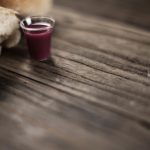There’s a difference between tidying and cleaning. Often, I’m more concerned with the former; my wife with the latter. Tidying involves putting shoes on racks, clothes into drawers, books on shelves, and toys in bins. Cleaning requires vacuuming, mopping, spraying, wiping, scrubbing, and magic-erasing. To my eyes, at least, tidying makes a more immediate, obvious difference. But cleaning reaches deeper, and its effects last longer.
Many people turn comprehensive cleaning into a yearly ritual, “spring cleaning.” If at no other time, once a year the whole house is scoured into shape.
Did you know that in the law God gave Israel through Moses, God himself instructed the people to clean his house once a year? How did that work? And what does it have to do with us Christians today?
Leviticus 16: Purging God’s People and Place
Leviticus 16 is a familiar passage, but we often miss this aspect of it. In the instructions this chapter gives for what is often called the Day of Atonement—or Yom Kippur—God appoints cleansing not only for the people, but also for his tabernacle. Why did God’s house need cleaning?
At the literary center of Leviticus 16, and at the center of the actions it prescribes for this day, is a sin offering brought into the Holy of Holies, the innermost room of the tabernacle, God’s portable dwelling with his people (Lev. 16:15–19). This was the only time when anyone was permitted to enter the Holy of Holies, and only the high priest was granted entry (cf. Heb. 9:6–7). The high priest was instructed to kill the goat of the sin offering, collect its blood in a bowl, enter the Holy of Holies, and sprinkle the blood over and in front of the mercy seat (Lev. 16:15).
To what effect? “Thus he shall make atonement for the Holy Place, because of the uncleannesses of the people of Israel and because of their transgressions, all their sins.” And what happens to the innermost room happens to the whole: “And so he shall do for the tent of meeting, which dwells with them in the midst of their uncleannesses” (Lev. 16:16).
Leviticus 16 teaches us sin not only burdens us with guilt, it also stains us and whatever we touch. Sin makes us both unclean and transmitters of uncleanness. Through the tabernacle, God dwelt with the Israelites in a special way. But their sin came between them and God. The people’s sin dirtied God’s house. It threatened to push away the God who graciously chose to dwell with them (Ex. 29:45–46; Lev. 26:11–12).
Leviticus 16 teaches us sin not only burdens us with guilt, it also stains us and stains whatever we touch.
So, this divinely appointed yearly cleaning of God’s had two effects: the Day of Atonement purged God’s people and his place. We see both in Leviticus 16:33: “He shall make atonement for the holy sanctuary, and he shall make atonement for the tent of meeting and for the altar, and he shall make atonement for the priests and for all the people of the assembly.”
Jesus’s Offering in Hebrews
But sin’s problems go even deeper than what Leviticus 16 tells us. Israel’s sins eventually piled up to such an extent that, as the Lord warned in advance, the land “vomited” them out (Lev. 18:24–25). Ultimately, the sins that Israel committed drove the Lord far from his sanctuary (Ezek. 8:6). In judgment, God’s glory departed from his sanctuary (Ezek. 10:1–22). And though God restored his people and enabled them to rebuild their temple, the underlying condition of sin persisted.
Persisted, that is, until Jesus came to deliver us. As Hebrews tells us, the fact that the Day of Atonement had to be repeated yearly signals that it wasn’t a final solution to sin: “For since the law has but a shadow of the good things to come instead of the true form of these realities, it can never, by the same sacrifices that are continually offered every year, make perfect those who draw near” (Heb. 10:1). But that is just what Jesus came to do.
The fact that the Day of Atonement had to be repeated yearly signals that it was not a final solution to sin.
On the cross, Jesus gave his life for ours, paying the price we deserved for our sins. Echoing Leviticus 17:11, Hebrews 9:22 reminds us, “[W]ithout the shedding of blood there is no forgiveness of sins.” In his death, Jesus “bore the sins of many” (Heb. 9:28). And then, on the third day, he rose from the dead, thereby obtaining “the power of an indestructible life” (Heb. 7:16). Jesus then did what the high priest on Yom Kippur only foreshadowed: he entered God’s Holy of Holies in heaven, and presented himself there to the Father as the perfect, sufficient, once-for-all sacrifice. Only in light of what we’ve seen in Leviticus 16 do passages like the following make sense:
Thus it was necessary for the copies of the heavenly things to be purified with these rites, but the heavenly things themselves with better sacrifices than these. For Christ has entered, not into holy places made with hands, which are copies of the true things, but into heaven itself, now to appear in the presence of God on our behalf. Nor did he enter to offer himself repeatedly, as the high priest enters the holy places every year with blood not his own, for then he would have had to suffer repeatedly since the foundation of the world. But as it is, he has appeared once for all at the end of the ages to put away sin by his sacrifice. (Heb. 9:24–26; cf. 9:11–12)
By entering God’s dwelling in heaven and presenting himself to God, Jesus perfectly purged God’s people and his place. On the cross, Jesus was slain as the spotless victim whose blood purchases our eternal life (Heb. 9:22, 28; cf. 9:15; 13:20). After rising again, he was appointed high priest in the order of Melchizedek (Heb. 5:7–10; 7:11–28). Then, after ascending to heaven (Heb. 4:14; 7:26), Jesus offered himself, his body, his blood, by presenting himself alive to God in the throne room of God’s heavenly tabernacle (Heb. 7:27; 8:1–5; 9:11–14, 23–28; 10:10–14; 12:24).
In addition to cleansing God’s dwelling in heaven, Jesus’s heavenly offering obtained for us perfection (Heb. 10:14), redemption (Heb. 9:12), forgiveness (Heb. 10:18), and unhindered access to God forever (Heb. 4:16, 10:19–20).
Deepest Deep Clean
Parts of this reading of Hebrews might be new to you. Many Christians have understood Hebrews to locate Jesus’s offering exclusively on the cross. But a deeper understanding of Leviticus 16 can help us understand the book of Hebrews better, too. The high point of the Day of Atonement was what the high priest did in the Holy of Holies. Hebrews itself tells us this when it reminds us that only the high priest could enter the Holy of Holies, “and he but once a year, and not without taking blood, which he offers for himself and for the unintentional sins of the people” (Heb. 9:7).
Where and when did the high priest make his offering? When he entered God’s earthly inner sanctum. Where and when did Christ make his offering? When he entered God’s heavenly inner sanctum, after rising from the dead and ascending to heaven. This in no way downplays or diminishes the cross, since the cross is where Jesus gave his life for ours, defeated death, bore the curse of the old covenant, and inaugurated the new (Heb. 2:9, 14–15; 9:15–17; 13:20). By presenting himself alive to God in heaven, Christ presented to the Father what his death on earth accomplished. In heaven, Christ offered to God what he achieved on the cross.
This is the cleansing we need far more than any spring cleaning. And it’s the deepest deep clean that can never—and need never—be repeated.
Is there enough evidence for us to believe the Gospels?
 In an age of faith deconstruction and skepticism about the Bible’s authority, it’s common to hear claims that the Gospels are unreliable propaganda. And if the Gospels are shown to be historically unreliable, the whole foundation of Christianity begins to crumble.
In an age of faith deconstruction and skepticism about the Bible’s authority, it’s common to hear claims that the Gospels are unreliable propaganda. And if the Gospels are shown to be historically unreliable, the whole foundation of Christianity begins to crumble.



































